||| EARTHRISE BY JAY KIMBALL |||
Buckets of rain
Buckets of tears
Got all them buckets comin’ out of my ears
~ Bob Dylan
I woke up to the roar of extreme rain pelting the metal roof of my home. The overflowing gutters released sheets of water, slapping on the deck below. I looked out the window to ensure the French drain was working. Yes! It was gushing like a firehose, flush with runoff collected from uphill behind the house. It was 15 November 2021.
Around Orcas Island, the rain fell so intensely that super-saturated hillsides melted onto the roads below, covering them with mud and uprooted trees. The Doe Bay bridge washed out. And overwhelmed drainage systems and culverts become ponds that took days to drain.

In neighboring Bellingham, water was up to the windshields of cars trapped in downtown streets. Over 500 people were displaced.
Ferndale residents worked for eight hours, placing over 3,000 sandbags to protect the levee. A major highway bridge in BC washed away in a river torrent.
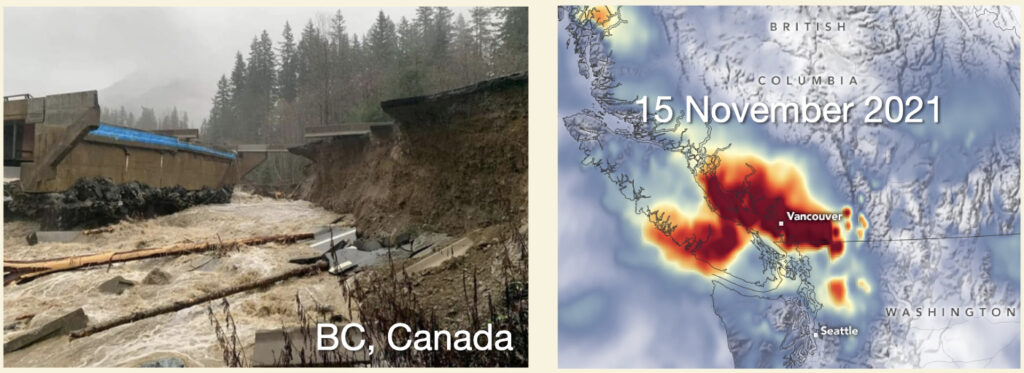
Average Rainfall Data is Misleading
Washington state climatologists predict this century will see only modest increases in annual northwest rainfall. But annual averages hide important detail like infrequent, but massive, extreme rain events. It’s like saying the average height of a family is 3.5 feet. The fact that that there are two 1 foot tall babies and two 6 foot tall adults are important details.
The chart below shows how the Bellingham extreme rain event far exceeded the averages.
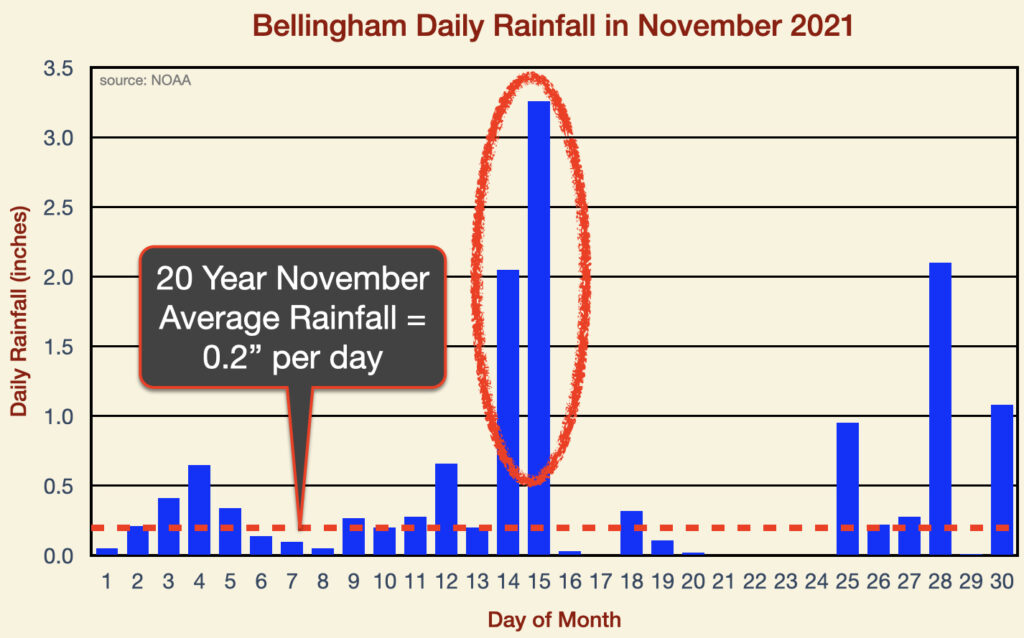
And remember, in our climate-disrupted weather weirding world, extreme rain months are often balanced by extreme drought months, as we saw in California this past year. So the annual averages can look deceptively mellow, despite the extreme weather shocks.
Since 1960, Extreme Rain Days Have Become More Intense and More Frequent
Extreme rain events are on the rise – increasing in intensity and occurrence. Research by Lloyds Insurance, looking at London rainfall patterns, showed a ten-fold increase in extreme rain events after 1960, when fossil-fueled post-World War II economies started going exponential.
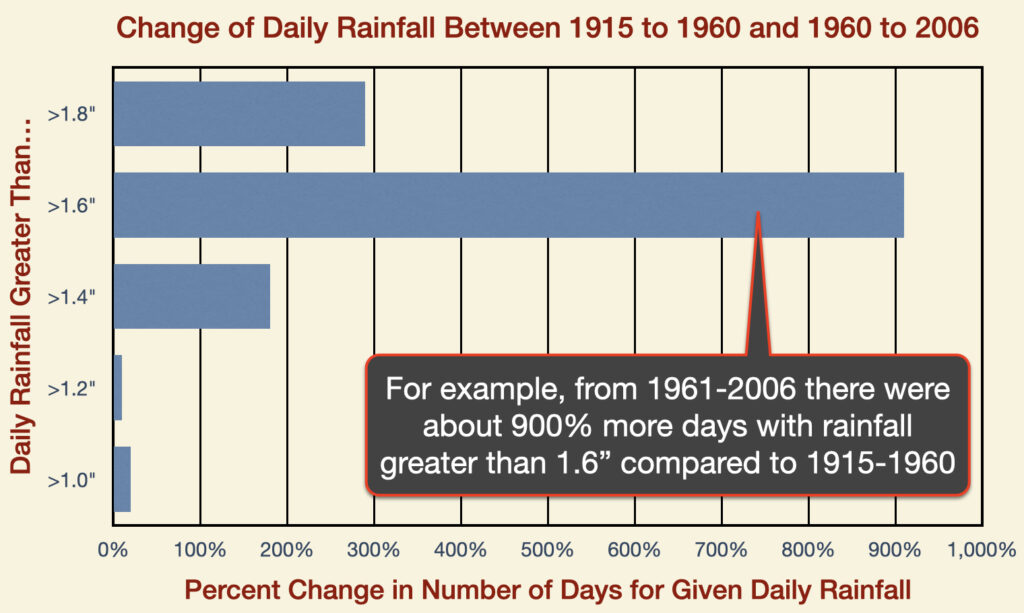
The Environmental Protection Agency (EPA) confirmed this trend, reporting nine of the top ten years for extreme one-day precipitation between 1910 and 2020 occurred since 1996. The EPA added, “the prevalence of extreme single-day precipitation events remained fairly steady between 1910 and the 1980s but has risen substantially since then.“
Supercharging the Atmosphere
“The frequency and severity of landfalling ‘atmospheric rivers’ on the U.S. West Coast … will increase as a result of increasing evaporation and resulting higher atmospheric water vapor that occurs with increasing temperature,” ~ Fourth National Climate Assessment
Burning fossil fuels stokes the greenhouse effect, continually supercharging Earth’s atmosphere and oceans with energy, in the form of heat. One study estimates we are adding 250 trillion Joules per second (equal to two Hurricane Sandys per second, detonating four atomic bombs per second, or 500,000 lightning bolts per second).
We Can’t Afford 100-Year Storms Every 10 years
The chart below shows the number of billion-dollar disaster events in the US, from 1980 to the present. Note how the yellow and green storm-related events really kicked into gear since 2000.
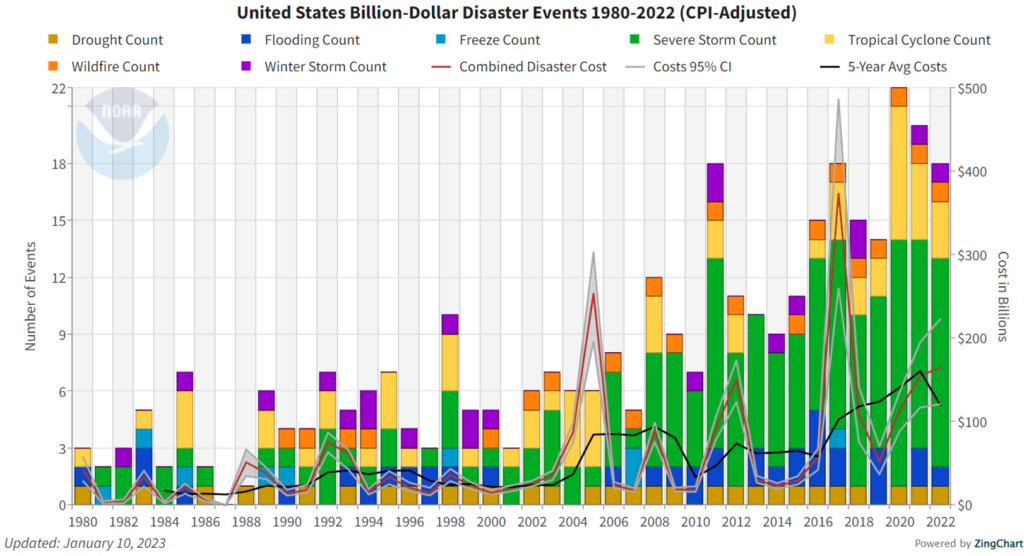
Climate Change = Insurance Risk = Home and Business Risk
“More insurance companies pull out of Louisiana: ‘We are in a crisis.’ Thousands of Americans living in the southern United States no longer have home insurance due to companies leaving the region after years of crushing storms.” ~ January 2023 news report
According to FEMA, just one inch of floodwater can cause up to $25,000 in damage in a typical home. In California, most people can’t afford earthquake insurance. As extreme rain accelerates and insurance companies readjust their climate risk calculus, we may not be able to afford insurance for storm damage.
Houston, Texas, has experienced 500-year floods three years in a row, including one caused by Hurricane Harvey. This has prompted revising the city’s zoning regulations to account for changes in the flood drainage basins around Houston.
“We expect to see many similar revisions as climate change alters the frequency and intensity of extreme events, and the rapid sprawl of cities shrinks the natural areas available to absorb floodwater.” ~ The World Bank
“Climate change is the No. 1 long-term risk out there,” said Jerome Haegeli, chief economist for reinsurer Swiss Re. The global insurance sector topped $5 trillion in 2021, comparable to recent US federal budgets. In a survey of insurance industry regulators, more than half indicated that climate change was likely to have a high impact or an extremely high impact on coverage availability and underwriting assumptions.
Preparing for Extreme Rain
The world is working to reduce greenhouse gas emissions. But it is going to take years before we are at net-zero. So extreme rain events will likely continue to grow in intensity, and happen more often. How do we prepare for this?
San Juan County has some excellent emergency preparedness resources. See Islands Ready link in Notes below.
Extreme rain can happen any time of the year, so keep your gutters clean year-round. And make sure they drain away from your foundation. Ensure the drains are in areas that will slow the runoff to allow for absorption into the ground.
Landscape friend Robin Kucklik has some tips:
- Study how stormwater moves through your property. Where does it run? Where does it pool?
- Look for signs of erosion. If significant, consult with a professional excavator company.
- Minimize impervious surfaces.
- Ensure that all bare, exposed ground is covered with 3” of mulch material. This is very important. A heavy rain event can take away a lot of topsoil if it is not protected with mulch. The Exchange, Sea Island Sand and Gravel are good sources for wood chip mulch. Or create your own mulch from yard waste.
- Mulch your garden areas regularly. The soil microbes will break down the mulch over time, so it’s necessary to renew it every three years.
- Consider creating a rain garden to capture the excess water, slow it down and help it infiltrate deep into the ground. There is good information available through our state and county conservation agencies. A little searching on the internet will give many suggestions on how to install an effective rain garden. Done well, they can be a visual asset to the landscape. More importantly, they provide seasonally moist habitat for many creatures – birds, amphibians, pollinator insects, etc.
Islander John Clancy recommends the work of Zach Weiss, a water restoration practitioner. See the Notes below for links for an overview and a deeper dive into water restoration work in the context of restoring the full hydrological cycle.
And Yale Climate Connections does excellent work curating useful, insightful climate information. In the Notes below, there’s a link that includes several valuable tips to prepare for extreme rain and flooding.
Earthrise: A Climate Action Journal
This climate action journal offers information and actions we can take together, locally and globally, as we care for this precious Earth.
“The best way to heal a living system, is to connect it with more parts of itself.” ~ Margaret Wheatley
If you like what you read here, pass it forward to a few friends and ask them to do the same. Like a pebble tossed in a pond, the rings emanate outward, reflecting and growing exponentially. “Going exponential” is what it will take to reverse the climate extremes that are accelerating around us.
Thank you…
• Get an alert when there’s a new Earthrise post: Subscribe
• Previous Earthrise posts: • First Light • Robert Dash – photographer, educator, environmentalist •
Notes
Islands Ready – County Emergency Preparedness Guide
Rain Gardens – Washington State University
Rain Gardens – Washington Department of Ecology
12,00 Rain Gardens in Pudget Sound
Yale Climate Connections – a great website for all things Climate Change
How is Pacific Northwest Climate Projected to Change?
UW Projected Changes in Extreme Precipitation Tool
The Cost of Climate Disruption – Climate. gov
The Cost of Climate Disruption – NOAA
Fourth National Climate Assessment
Fourth National Climate Assessment – Atmospheric Rivers
Insurance Industry on Climate Disruption – Swiss Re
Insurance Industry on Climate Disruption – Whitepaper
Walter Jehne: Regenerating the Soil Carbon Sponge
Community Water Stories from Zach Weiss
Community Water Stories from Zach Weiss – Water Cycle Restoration
The Skeptical Science Website – how much energy we are putting into Earth’s oceans and atmosphere
The Skeptical Science Website – California megafloods
The Skeptical Science Website – Hurricane Sandy, extreme rain, + sea level rise
Nature – Extreme Rain + Sea Level Rise
Tropical cyclone climatology change greatly exacerbates US extreme rainfall–surge hazard

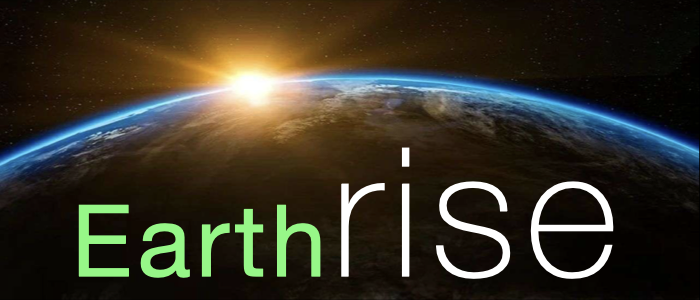



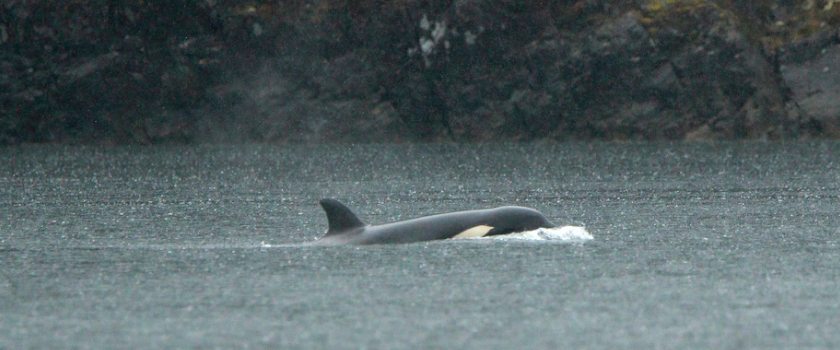



Jay,
I love your series Earthrise!
Our neighbors to the north in British Columbia relied on grand engineering projects to dike and then drain an enormous shallow lake. Failure of part of the levees resulted in catastrophic flooding during the 2021 “Deluge”.
The Narwhal reports: More dikes and bigger dams could be a multi-billion dollar mistake: here’s how B.C. could ‘build back better’
https://thenarwhal.ca/bc-flooding-atmospheric-river-recovery-solutions/
Great job, Jay!
I formed the first storm drain utility in Washington (City of Bellevue) in 1973. There are some fascinating legal considerations such as under the state constitution, the state owns and regulates ground water. But local governments control surfaces- roofs, driveways, parking lots and roads, sluicing rainwater away from underground recharge, impovereshing a vital reservoir. By law, state highways can concentrate and dump their storm drainage onto the localities through which they pass. There has been no overall “Big Think” about a resource we cannot do without. People may get around to this some day.
Thanks, Jay! Another great post. I’m particularly interested in the rain garden concept. As you know we experienced flooding in November 2021 and are keen the prevent it happening again.
Green roofs have always intrigued me.
Stormwater Best Management Practice – Green Roofshttps://www.epa.gov › system › files › documents
Green roofs are a green infrastructure alternative to conventional roofs that reduce stormwater discharge and provide a wide range of additional environmental …
We have a 2500 gal rainwater catchment system that we use (only) for watering the garden and filling the spa. Not very drinkable.
Yes. Robin Kucklick talks about how “Water wants to go somewhere.” In his landscape work, he looks for ways to give water time to dwell, to absorb into the earth, replenishing precious groundwater stores. I recall a tour John Clancy and Robin gave of OPAL Community Land Trust’s Wild Rose Meadow. The property features a large community food garden, with individual plots and a shared orchard. A pond is integrated into a verdant wetland. To increase the opportunity for storm water to infiltrate into the aquifer under the property, the design includes pervious pavement, gravel-paved paths, and densely vegetated buffers. A water-wise oasis. The birds love it too!
For those who are interested in installing a rain garden on their property Washington State University offers an excellent description of the process.
https://extension.wsu.edu/raingarden/homeowner-resources/
Great resources and documentation, Jay! So much practical, important information here–thanks for all the time you put into this.